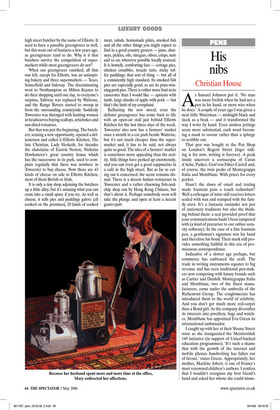His nibs
Christian House
As Samuel Johnson put it: ‘No man was more foolish when he had not a pen in his hand, or more wise when he does.’ A couple of years ago I was given a neat little Waterman — midnight black and sleek as a beak — and it transformed the way I write by hand. Even aimless jottings seem more substantial, each word becoming a mark to savour rather than a splurge to scribble out.
That pen was bought at the Pen Shop on London’s Regent Street (logo: talking is for now, writing is forever). A peak inside uncovers a cornucopia of Caran d’Ache, Parker, Graf von Faber-Castell and, of course, the twin peaks of Montegrappa Italia and Montblanc. With prices for every pocket.
Hasn’t the dawn of email and texting made fountain pens a touch redundant? Well a colleague of mine still receives letters sealed with wax and stamped with the family crest. It’s a fantastic reminder not just of stationery traditions but also the thinking behind them: a seal provided proof that your communications hadn’t been tampered with (a kind of precursor to our online security software). In the case of a fine fountain pen, a gentleman’s signature was his hand and therefore his bond. Their mark still provides something faithful in this era of promiscuous correspondence.
Indicative of a slower age perhaps, but commerce has embraced the craft. The trade in writing instruments equates to big revenue and has seen traditional pen-makers now competing with luxury brands such as Cartier and Dunhill. Montegrappa Italia and Montblanc, two of the finest manufacturers, come under the umbrella of the Richemont Group. The conglomerate has introduced them to the world of celebrity. And you don’t get much more red-carpet than a Bond girl. As the company diversifies its interests into jewellery, bags and watches, Montblanc has appointed Eva Green its international ambassador.
I caught up with her at their Sloane Street store as she inaugurated the Meisterstück 149 initiative (in support of Unicef-backed education programmes). ‘It’s such a shame that with the growth of the internet and mobile phones handwriting has fallen out of favour,’ states Green. Appropriately, her mother, Marlène Jobert, is one of France’s most renowned children’s authors. I confess that I wouldn’t recognise my best friend’s hand and asked her whose she could imme diately identify. ‘My agent,’ laughs Green, as said lady nods approvingly behind her.
Meanwhile, Montegrappa has Paolo Coelho as its spokesman, strengthening their reputation as the pen pusher of choice for authors. To hear how they work in tandem with their German counterparts, I lunched with their brand manager, Patrick Rudomino. Patrick is the embodiment of the more refined aspects of Europe. Half Swedish, half Polish, he possesses the easy demeanour and relaxed charm of the unfazed chameleon. Equally at home in Geneva or Acton, he’s like Cary Grant with a smörgåsbord accent. It’s soon apparent that his pens are equally polished.
‘Many people ask, what is the difference between Montblanc and Montegrappa?’ admits Patrick. ‘Montblanc is a beautifully crafted product but for a very different consumer. It’s a bit like comparing a Mercedes and a Ferrari. Two very good established brands but two very different customers.’ In this equation, Patrick asserts, Montegrappa is the Ferrari: the focus is very much on the Italian craftsmanship that has shaped these sublime objects since 1912. A few years later, during the first world war, Ernest Hemingway found himself holed up next to the Montegrappa workshops in Bassano del Grappa and promptly filled his notebooks using their wares.
Their image may have become slicker but there’s no denying that fountain pens have remained a predominantly male preoccupation. The high-end models are status-symbol items with practical applications, the desire for which has fuelled man’s longing for anything from a Hardy Amies overcoat to a leatherstrapped Breitling. It’s also a world steeped in its own lexicon. Jewellers count their carats and articulate their bands while watch nuts keep an eye on their perpetual calendars and subsidiary dials. Meanwhile, dedicated ‘nibbers’ are concerned with button fillers and piston reservoirs. Boys will be boys.
While a Montblanc pen is instantly recognisable, with its black casing and snowy logo, Montegrappa has pursued a more eclectic, unfettered approach to design. Their limited edition pens have taken inspiration from such disparate subjects as the Bibliotheca Alexandrina, Antonio Stradivari and the American gold rush.
Makers have always experimented with materials. Gold, platinum and sterling silver abound for clips, rings and ornamental additions while bodies also draw on the benefits of resin, ash and ebony. As befitting its origins as an 18th-century pencil maker, Graf von Faber-Castell in particular has mastered the use of wood in luxury pens. Montegrappa differentiates itself with a bold use of colourful celluloid, a by-product of cotton that takes 18 months to produce. The result is an electric mother-of-pearl effect. ‘Everybody needs a bit of colour in their life,’ smiles Patrick. ‘We live in quite stressful and greyish times.’ The nibs, it should go without saying, are all 18 carat gold. So, finally, how do you cap it all off? Do you twirl and screw or clunk and click? My Waterman closes with a crisp, satisfying snap while the stogie-shaped Montegrappa Miya which Patrick hands me sheathes with a pirouette. Of course, both serve the purpose and personal preference is all. It’s a little like asking whether you prefer to button or zip your flies.
The result of my investigations into this arcane domain is that my Waterman now has company. A Montegrappa Miya Argento stands at its side, blue-swirling-celluloid catching the light. The pair form a tag team: the Waterman for on-the-go ops while Monty steps in for ceremonial duties. Of course, it is a sign of these hard-drive days that neither of them assisted in filing the copy for this piece but rather Messrs Apple and Outlook. Prosaic, but there was at least no need for a blotter.



















































































 Previous page
Previous page